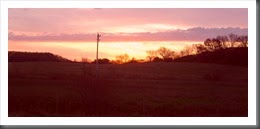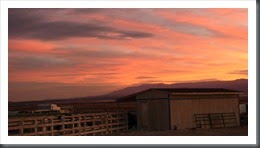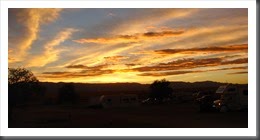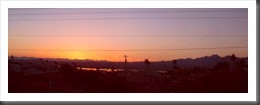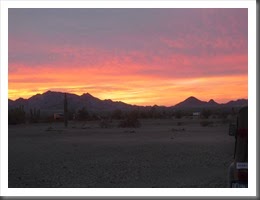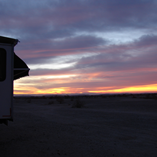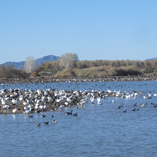Where are we now?
Home is where you park it, and for us right now it is in Winterhaven, California about 4 miles north of I-8. We are boondocking at some very familiar BLM land known as Ogilby Road (SR-34). We spent some time here last year when Kay was having dental work done in Los Algodones, Mexico. It is at this desert location that we have the greatest opportunity to explore areas in and around this remoteness which sits on the border of California and Arizona. How unique is that? Definitely not for everyone, but we love the adventure. We do admit that It is nice to come back to an area that you are a little familiar with. Now we can check out areas that we didn’t get to last year as well as visit our favorites a second time around. Retirement, lets you do that.
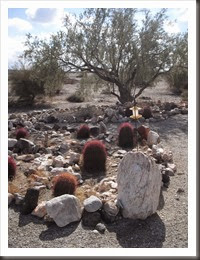 |  |
On one of our hikes at Ogilby, we walked on a different angle towards the Chocolate Mountains and low and behold we came across a beautifully arranged rock garden – complete with barrel cacti – that someone took the time to build. Proceeding further, we arrived at a site that looked like the Aztec gods had left a message in the rock surface. No, man-made it was and quite unusual. The pattern and rock placements at the site were asymmetrical that we were quite mystified about how it was built. None-the-less we spent some time there enjoying the beauty of rock and sand.
|
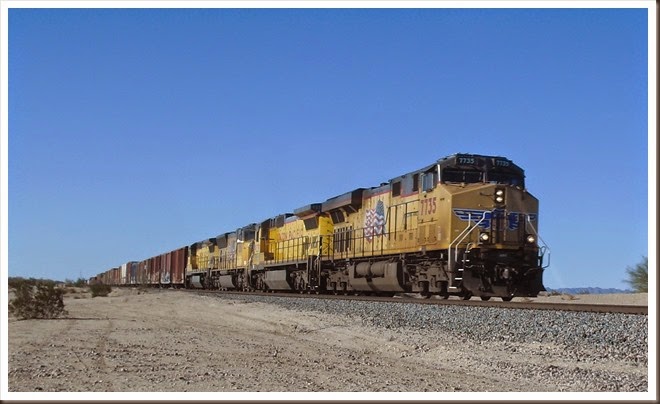 |
We do hear the trains at this location in the desert and can actually see them throughout the day (when we are home). We can say with pride that we are “Rail Fans”. A term that we just learned of from our good friend, Bill in Phoenix, who can tell you anything you want to know about trains. As we were watching the oncoming train, the engineer sounded his horn to tell us that he appreciated our support.
Notice the image of the American Flag on the first engine. Jeff’s picture captured it just perfect. |
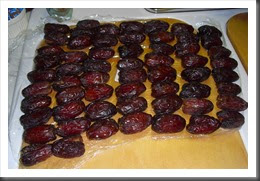 |
Medjool dates are a must for us when we are in California so a trip to Bard, California has now become an annual road trip for us. We stop at Berryman Farms where you can also buy a date shake if you want. Too sweet for us! |
We were fortunate to hook up again with our friends from Alberta, Canada – Sheila and Chuck. They too parked at Ogilby Road to become our neighbors for a week. Spending time with their friend (and now ours too), Betty from Prince George, BC was so much fun. She treated us to a home made dinner complete with a desert of Raisin Pie at her winter home in the Foothills (outside of Yuma). It was delicious and a pie that Kay had never had before!
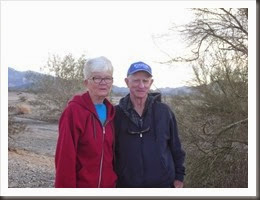
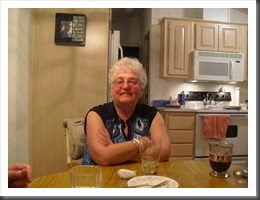
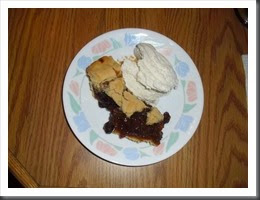
Can’t forget our other friends from Alberta who were visiting for the day – Lynn and Fred. Lynn doesn’t like to have her picture taken so I was able to get Fred in a very relaxed position. Fred just recently celebrated quite a milestone too by turning the big 80. Looks pretty good for a “geezer”, doesn’t he? Both of them have traveled many miles during their retirement years. Lynn is an awesome writer and chronicles their travels via their blog -
http://firstep-andlifegoeson.blogspot.com
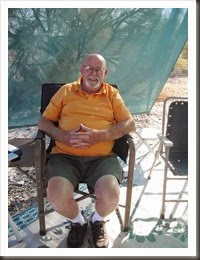
What a hoot we had sharing a fun day in Mexico with Sheila and Chuck. Jeff standing at a counter at one of the many pharmacies in Los Algodones and then the waiting in line process to go through customs with our purchases.

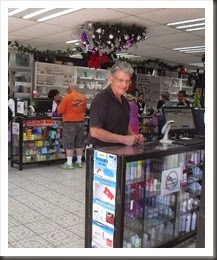

We purchased jumbo shrimp that is brought in daily from Rocky Point. Jeff had his first experience of cleaning & deveining of the shrimp and did a great job. Then we marinated them in a homemade recipe that we got from from a friend when we were in in Terlingua, Texas in 2012 and then they were off to the grill.
And on the sweeter side, homemade apple fritters – THE BEST – from the small bakery tucked into one of the courtyards. We put them on our mini-toasters and heat them up a little on the stove. Delish!! | 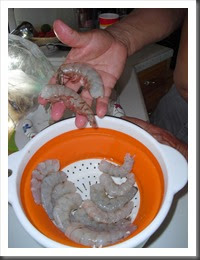 | 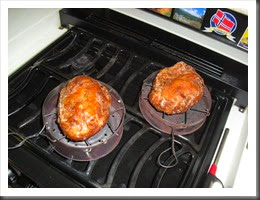 |
And now for the highlight of this update. . .it’s time to check out some new scenery in the Jeep. We hope that you enjoy the ride with us through the Lower Colorado River Basin.
Picacho State Recreational Area (pronounced “Pie-ca-chew”)
This park resides 25 miles north of Yuma, Arizona and lies along the California side of the Colorado River.
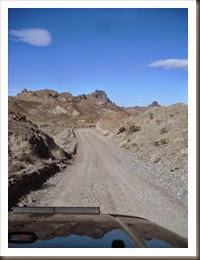 | 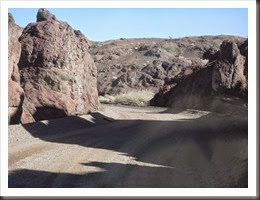 |
The remoteness definitely invites those that seek adventures (that’s us!) as it begins with a 24-mile approach which is paved only for the first six miles. The next 18 miles composed of rough dirt becomes quite the challenge and one that takes you into some pretty amazing areas of the desert. |
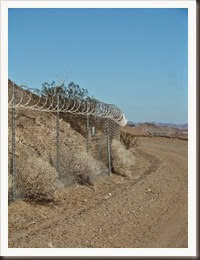 |
The history of the park goes back thousands of years, the Quechan and other native people of the Great Basin culture lived along this part of the Colorado River. Today the federally-recognized Quechan – one of California’s largest inland native groups – consist of about 3,000 people, many of whom still speak their native language.
Picacho was at one time a large-scale mining operation that was opened by placer miners after 1852, employing 700 miners during its peak from 1895 to 1900. At the turn of the 20th century steam-powered paddleboats were bringing supplies and people to the area. As the mines were depleted so was the community. Today the site is a state park.
The photo to the left is where the Picacho Mine resides. We’re sure you can tell what the message is by all of the barb wires that is currently surrounding the mine. There were places along the road where rain erosion has occurred and literally pulled out sections of the barbed wire totally down on the ground – not being touched due to the safety risks. What a mess. |
Once you’ve reached the park and register for a day pass we were pretty impressed on what the park offers: 54 primitive campsites at the main campground, canoeing and kayaking down the river, fishing (black bass, catfish, striped bass and bluegill), boating and exploring (4WD and hiking). Lots of things to do if you really want to be “remote” in the main sense of the word or should we say - it’s definitely an invitation for hardy (as in hard) adventurers. We’ll pass on this one; just a little too remote for us.
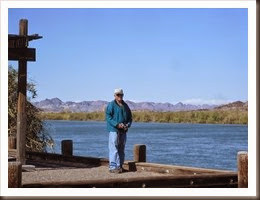 | 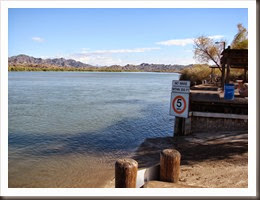 |
These photos are of the Upper Dock area which were quite nice - complete with boat launch, bathrooms and a picnic area. There is a Lower Dock area also that has two group camp sites for those that want to canoe on the river. Once again, very remote areas. |
We did take a side trail that was pretty much the highlight of the trip. This road was an old narrow gauge railroad that ran from the mine to the mill and the grade is still there, but it ends quite literally at the River Outlook. Quite a beautiful sight of the Colorado River as it cuts through the rugged scenery of the park.
Beauty is in the eye of the beholder. On our way out, Jeff’s eye happened to see the skeleton of a dead brittle bush. A stark comparison next to the drab dark color of the desert at this tie of year. Quite a unique picture of its own with the sun shining on it. It reminds us of the precious coral that lives in the ocean. What does it remind you of?
Another day . . . another Jeep trip . . . | 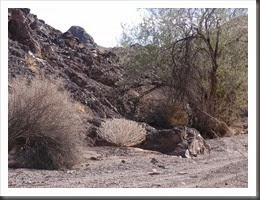 | 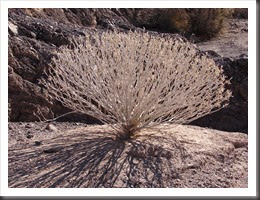 |
Cibola National Wildlife Refuge
This refuge is located along the lower Colorado River 20 miles south of Blythe, California. Approximately two-thirds of the refuge is in Arizona and one-third is in California which encompasses 17,267 acres. Our main interest in exploring this area was to check out the BLM (14-day limit) campground run by the State that was within the refuge. Sites were small with some by the river, but the scenery and the one lane bridge that took us across the Colorado River - and into Arizona –was so much fun to investigate it while in the Jeep.

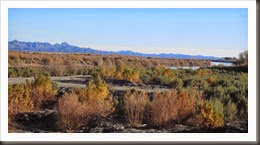
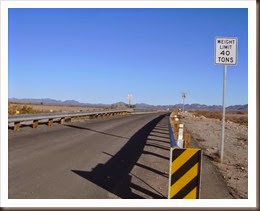 |  |
We weren’t even aware of any bridge crossings over the Colorado River until we learned of this one-lane bridge within the refuge made of wood planks. A second similar bridge is located another 20 miles further down on the river. Nothing on regular maps to tell you of this. It must be a secret! |
The refuge contains 2,000 acres of farmland and 785 acres of desert foothills and ridges. The area is important as a wintering ground for the western (or Great Basin) subspecies of Canada goose and for Sandhill Cranes. Many ducks also spend a portion of the winter here. They say that there are over 288 species of birds that have been found on Cibola NWR but for us on this visit a short drive to the Visitor Center to enjoy a 3-mile auto tour loop (also known as Canada Goose Drive) was only the beginning of how awe-stuck we were when we spotted the wildlife. This occurred about half-way around the trail where we were able to view thousands of Canada geese, snow geese, ducks and Sandhill Cranes – all in a 20-acre pond. It is estimated that the population of Sandhill Cranes contains approximately 2,000 birds and is the largest flock found at Cibola. It was truly an experience neither of us will ever forget. And then to top it off watching literally hundreds of European Starlings in the field making crazy patterns in the sky. What a fun sight to see!
Special thanks to the chauffeur!!!!!
“What day is it?” asked Pooh.
It’s today.” squealed Piglet.
“My Favorite day.” said Pooh
| 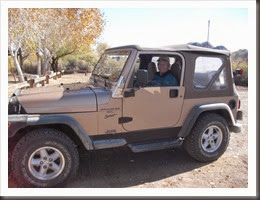 |
Hugs

